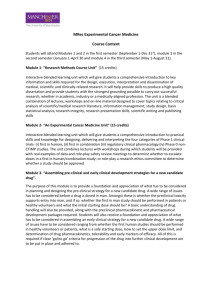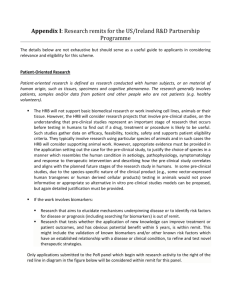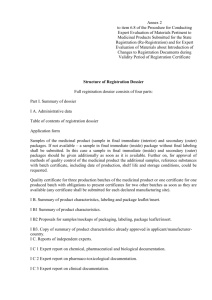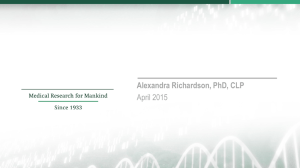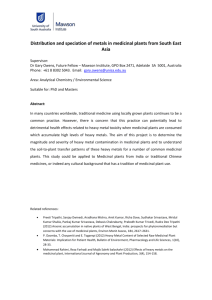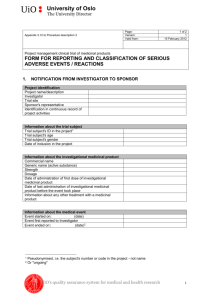poriadok_944_eng_AV
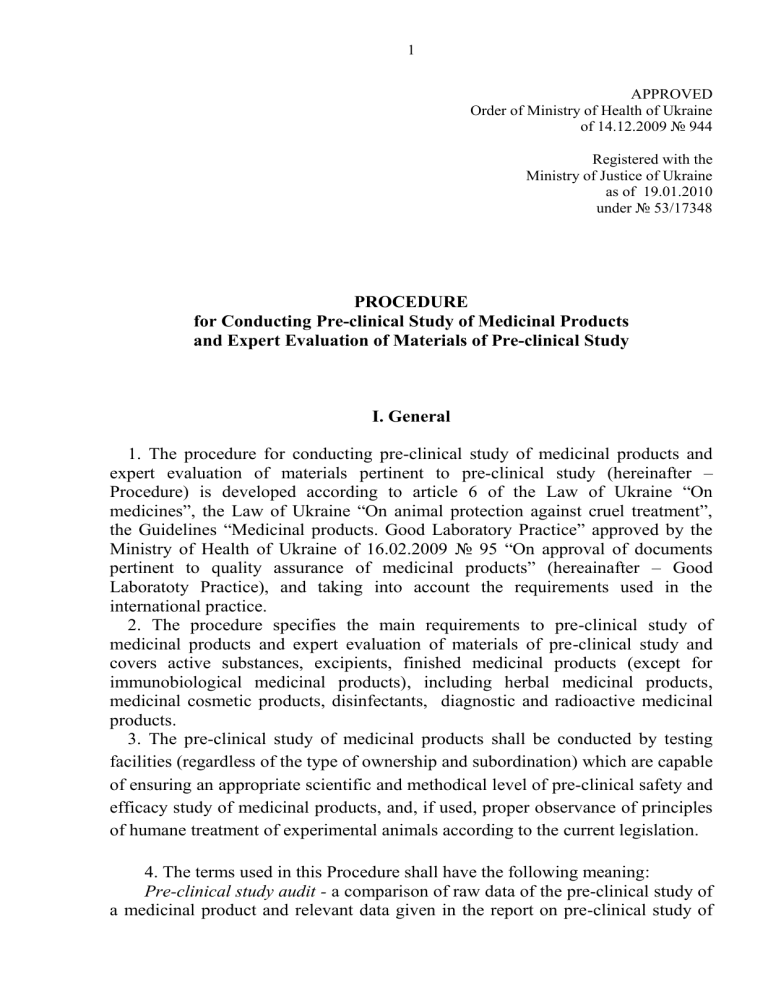
1
PROCEDURE
APPROVED
Order of Ministry of Health of Ukraine of 14.12.2009 № 944
Registered with the
Ministry of Justice of Ukraine as of 19.01.2010 under № 53/17348 for Conducting Pre-clinical Study of Medicinal Products and Expert Evaluation of Materials of Pre-clinical Study
І. General
1. The procedure for conducting pre-clinical study of medicinal products and expert evaluation of materials pertinent to pre-clinical study (hereinafter –
Procedure) is developed according to article 6 of the Law of Ukraine “On medicines”, the Law of Ukraine “On animal protection against cruel treatment”, the Guidelines “Medicinal products. Good Laboratory Practice” approved by the
Ministry of Health of Ukraine of 16.02.2009 № 95 “On approval of documents pertinent to quality assurance of medicinal products” (hereainafter – Good
Laboratoty Practice), and taking into account the requirements used in the international practice.
2. The procedure specifies the main requirements to pre-clinical study of medicinal products and expert evaluation of materials of pre-clinical study and covers active substances, excipients, finished medicinal products (except for immunobiological medicinal products), including herbal medicinal products, medicinal cosmetic products, disinfectants, diagnostic and radioactive medicinal products.
3. The pre-clinical study of medicinal products shall be conducted by testing facilities (regardless of the type of ownership and subordination) which are capable of ensuring an appropriate scientific and methodical level of pre-clinical safety and efficacy study of medicinal products, and, if used, proper observance of principles of humane treatment of experimental animals according to the current legislation.
4. The terms used in this Procedure shall have the following meaning:
Pre-clinical study audit a comparison of raw data of the pre-clinical study of a medicinal product and relevant data given in the report on pre-clinical study of
2 medicinal product to determine whether the raw data of pre-clinical study is accurately reported, to determine whether testing is carried out in accordance with the study protocol (plan) of the pre-clinical study and standard operating procedures, to obtain additional information not given in the pre-clinical study report, and to evaluate the appropriateness of the method employed in the development of raw data and the compliance of the conducted preclinical study with Good Laboratory Practice;
Multisite pre-clinical study - study which is conducted at more than one site/test facility according to a single protocol (plan) of a preclinical study;
Raw data – all original test facility records and documentation, or copies thereof verified by the Study Director, which are the result of the original observations and activities in a study. Raw data also may include, for example, photographs, microfilm or microfiche copies, computer-readable media, dictated observations, recorded data from automated instruments, or any other data storage medium that has been recognized as capable of providing secure storage of information;
Study plan deviation an unintended departure from the study plan after the study initiation date;
Secondary pharmacodynamics – a section of pharmacodynamics which investigates the mode of action and effects of a medicinal product not related to its desired therapeutic target;
Principal investigator an individual who, for a multisite study of a medicinal product, acts on behalf of the study director and has defined responsibility for delegated phases of the preclinical study of a medicinal product;
Experimental starting date the date on which the first pre-clinical studyspecific data are collected;
Experimental completion date the last date on which data are collected from the pre-clinical study;
Study initiation date the date the study director signs the pre-clinical study protocol (plan);
Study completion date the date the study director signs the pre-clinical study report;
Pre-clinical study of medicinal product – a set of chemical, physical, biological, microbiological, pharmacological, toxicological and other scientific investigations conducted prior to initiation of the clinical trial. Pre-clinical study of a medicinal product includes pre-clinical studies in the laboratory conditions and/or studies on laboratory animals with the purpose to determine a specific activity and safety of a medicinal product;
Testing facility – a legal entity with its subordinated divisions provided with personnel, premises, equipment, test-systems and other resources necessary to conduct pre-clinical study of medicinal products;
Expert evaluation of materials pertinent to pre-clinical study of medicinal product - verification, analysis and evaluation of materials of preclinical study of a medicinal product in order to prepare substantiated conclusions on safety and efficacy of a medicinal product;
3
Customer of preclinical study (sponsor) (hereinafter - Customer) – a legal entity regardless of the type of ownership or natural person, who initiates a preclinical study, defines its scope, agrees upon and finances a pre-clinical study of a medicinal product;
Pre-clinical study report – results of pre-clinical study and their analysis presented in writing;
Study director - the individual responsible for the overall conduct of the preclinical study;
Management of testing facility – an authorized person of a testing facility who heads and is responsible for organization and functioning of this facility;
Short-term study a study of a medicinal product of short duration with widely used routine techniques;
Materials pertinent to pre-clinical study of medicinal product – documentation pertinent to pre-clinical study of a medicinal product which includes reports on chemical, physical, biological, microbiological, pharmaceutical, pharmacological, toxicological and other experimental scientific investigations and/or literature data on composition, quality parameters and quality control methods, properties, specific activity and safety of a medicinal product, as well as pre-clinical study protocols (plans);
Good Laboratory Practice (GLP) is a quality system concerned with the organisational process and conditions under which pre-clinical health and environmental safety studies are planned, performed, monitored, recorded, archived and reported;
Primary pharmacodynamics – a section of pharmacodynamics, which investigates the mode of action and effect of a medicinal product in relation to its desired therapeutic target;
Amendment to pre-clinical study protocol (plan) – a written description of changes or formal text clarification of a pre-clinical study protocol (plan);
Specimen – any material derived from a test system for examination, analysis, or retention;
Quality assurance programme - established system which involves a personnel independent of the ongoing study and ensures to the management of the testing facility the study compliance with Good Laboratory Practice;
Protocol (plan) of pre-clinical study – a document which specifies a purpose and outline of the study and includes any amendments to it;
Reference item (control item) - any article used to provide a basis for comparison with the test item;
Vehicle – any agent which serves as a carrier used to mix, disperse, or solubilise the test item or reference item to facilitate administration/application to the test system;
Batch a specific quantity or lot of a test item or reference item produced during a defined cycle of manufacture which has similar properties and appropriately identified;
4
Standard operating procedures documented procedures which describe how to perform tests or activities normally not specified in detail in study plans or test guidelines;
Test item an article that is the subject of a pre-clinical study (test medicinal product, test substance);
Test-system any biological (animal, isolated organ, cell, tissue or cell culture, cell organelle, microorganism, etc.), chemical (reagents) or physical
(analytical equipment) system, or a combination, thereof used in a pre-clinical study;
Toxicology of medicinal product – determination of toxicity of a medicinal product and any adverse effect under the proposed conditions of its use in humans, and assessed with consideration of the appropriate pathological conditions;
Qualified person (of a manufacturer) – a natural person assigned by a manufacturer to be responsible for ensuring that all batches of a medicinal product are manufactured in compliance with main principles of good manufacturing practice, checked for compliance with a product specification and to issue a permission for each batch of a medicinal product to be sold or used in a clinical trial;
Pharmacodynamics – a section of pharmacology which investigates a pharmacological and therapeutic effects of medicinal products, a set of effects produced by medicinal products, modes of their action, development of their effect with time;
Pharmacokinetics – a section of pharmacology which studies processes of absorption, distribution, metabolism and excretion of medicinal products in human and animal organism with time;
Safety pharmacology – a section of pharmacology which investigates the potential undesirable pharmacodynamic effects of a medicinal product on physiological functions of a living organism.
5
ІІ. General principles of pre-clinical study
1.
Pre-clinical study of medicinal products shall be conducted along the following directions:
Establishing pharmacological efficacy of a medicinal product (primary and secondary pharmacodynamics and safety pharmacology);
Pharmacokinetics study: absorption, distribution, metabolism, elimination;
Toxicological study – determination of the potential risk in humans.
2.
Pre-clinical study of pharmacological properties of a medicinal product shall substantiate its efficacy in terms of use in humans.
3.
During the pharmacokinetic studies the data are obtained on absorption, distribution, metabolism and elimination of an active substance after single and repeated administration to animals. The pharmacokinetics of a medicinal product at oral administration shall be determined in big animals (dogs, rabbits).
If a medicinal product is intended for local use a systemic absorption shall be investigated considering its potential use on damaged sites of skin and absorption through the appropriate sites of body surface.
Systemic toxicity of repeated dose, as well as gonadotoxicity and embryotoxicity shall not be investigated provided there is evidence of lack of systemic absorption of a medicinal product intended for topical use. If during the pre-clinical pharmacological efficacy study the systemic absorption is detected the systemic toxicity, and, if applicable, gonadotoxicity and embryotoxicity study of a medicinal product shall be investigated in animals.
4.
Toxicological studies shall reveal the potential toxicity of a test item, health risk or non-intended toxic events which may occur in conditions of recommended use in humans. These data shall be evaluated considering the appropriate pathological conditions.
Pre-clinical toxicity and safety pharmacology study of medicinal products shall be conducted in compliance with requirements of Good Laboratory Practice which ensures quality and reproducibility of the data obtained.
5.
The local tolerance studies, including histological analysis, potential sensitization and potential carcinogenic effect studies, are required for all medicinal products intended for repeated administration.
6.
To prove safety and efficacy the programme of biological medicinal product study should be justified.
The following shall be considered while preparing such programme:
All pre-clinical studies which foresee the repeated administration of a test item shall be planned considering the potential stimulation of antibodies and their effect on the body;
During the pre-clinical study the expediency of pre-clinical study of reproduction function, embryonal/fetal and perinatal toxicity, mutagenic and carcinogenic potential shall be considered. If non-active pharmaceutical ingredients are proved to be a cause of toxicity the study may not be conducted in case the evidence of the deletion of these components from a medicinal product is provided.
6
7. The pre-clinical study of herbal medicinal products containing toxic substances shall determine their benefit/risk ratio at use in humans.
8. The scope of pre-clinical studies of biological/biotechnological medicinal products shall be determined considering their origin and production techniques.
9. During pre-clinical studies of radioactive medicinal products it should be considered that their toxicity may depend on a dose of radioactive emission, at the same time in case of diagnostic procedures the latter may be a cause of adverse effect of such medicinal products but in case of radiotherapy – the target characteristic. The pre-clinical safety and efficacy study of radioactive medicinal products shall be conducted considering the conditions of their use and dosimetry data. The emission effect on organs and tissues shall be indicated in the appropriate documents.
10. If an active substance is used in the pharmaceutical practice for the first time the toxicological studies shall be conducted.
11. In case of disintegration of a medicinal product during its storage the toxicological studies of the disintegration products, which may be produced, must be conducted.
12. The pre-clinical study of medicinal products shall be conducted using principles of bioethics and humane treatment of laboratory animals.
13. If a medicinal product is intended for pediatric population the preclinical study shall be conducted in juvenile animals.
14. The scope of pre-clinical study of a medicinal product shall be defined depending on the available information about it.
The scope of pre-clinical studies may be changed during the pre-clinical study of a medicinal product provided such changes are substantiated.
15. The methods used at pre-clinical study of medicinal products should meet a state of the art, their correctness should be proved by results of the methods validation.
16. The test item for pre-clinical study shall be submitted by a Customer and be accompanied by a certificate of quality for each batch signed by a Qualified
Person of the Manufacturer.
17. The appropriate mathematical and statistical methods ensuring proper assessment of the results obtained shall be used during the pre-clinical study.
18. A pre-clinical study report (Annex 1) to be issued to the Customer shall be drawn up according to the results of pre-clinical study of the test medicinal product.
19. All materials of pre-clinical study of a medicinal product shall be kept in the Customer’s archives for at least five years after termination of the pre-clinical study of a medicinal product.
7
IІІ. Types of pre-clinical study
1. Toxicity study of test item
1. The toxicity study of a test item at single administration of an active substance or a set of active substances (in proportions and physical-chemical state similar to those of the finished medicinal product) with the purpose of qualitative and quantitative study of toxic reactions which may occur due to this administration.
1.1. The acute toxicity study of a test item shall be conducted at least in two mammalian species of laboratory animals of well known strains or sometimes in one species provided there is appropriate justification. During such study at least two different routes of administration shall be used, one of which is identical or similar to that recommended for use in humans, and the other ensures systemic action.
1.2. Different manifestations of a test item toxicity shall be studied, including local reactions. The observation period of animals after administration of a test item should be sufficient to detect signs of damage or regeneration in organs or tissues; it should be 14 days. The shorter period should be justified.
The animals shall not be doomed to prolonged suffering; the dying or agonizing animals should be euthanized. All animals which died during observation period, as well as survived to the end of observation period shall be subject to dissection and macroscopic examination.
The comparative microscopic studies of internals shall be conducted in control animals and in animals which received the highest dose of a test item. If pathological changes are revealed in the latter the microscopic studies of internals of other test animals shall be conducted.
1.3. The single dose toxicity study of a test item shall detect the signs of acute toxicity and clarify the reason of animal death. The quantitative assessment of the approximate value of lethal dose shall be performed, and the information on dose/ effect dependence, and the high level of precision is optional. During these studies the information shall be obtained on probable manifestations of acute overdose in humans. This shall be a basis for planning repeated dose toxicity studies in animals.
1.4. The pre-clinical study of a combination of active substances is aimed at establishing the presence or absence of effect of the toxicity increase and detecting new toxicity manifestations.
2. The repeated dose toxicity study of a test item is aimed at establishing physiological and morphological changes induced by the repeated dose of a medicinal product, and determining the dose dependence on these changes.
2.1. Two types of studies shall be conducted:
- Short-term study (for 2-4 weeks);
- Long-term study, the duration of which depends on that of use of a medicinal product in humans, i.e. 3-6 months.
8
The purpose of such pre-clinical study is to determine the non-toxic dose range of a test item. Considering the intended duration of use of a medicinal product in humans the duration of a pre-clinical study may be shortened or prolonged (in case of appropriate justification). Only a short-term study may be conducted, if the test medicinal product is to be administered to a patient in single dose.
2.2. The dose range of a test item to be investigated should be justified.
2.3. The highest dose of a test item should ensure detection of its adverse effect on the test-system. The lower doses of a test item should ensure determination of doses of a test item which are tolerable for animals.
2.4. The repeated dose toxicity study of a test item should be conducted in two mammalian species, one of which should not be a rodent. The choice of route of administration of a test item shall be determined by the route of administration to be used in clinical use, and by potential systemic absorption of a test item. The mode and frequency of administration of a test item should be accurately specified.
2.5. During the experiments conducted in small rodents the pre-clinical study protocol and quality control methods should comply with tasks of the study and ensure reliability of results.
2.6. Determination of the number of animals in each dose group shall envisage the interim slaughter of animals and possibility of the study of reversibility of pathological changes if those occur.
2.7. Assessment of toxic effects of a test item should be based on observations of animal behaviour and clinical signs of toxicity, data on body weight dynamics, results of haematological and biochemical studies, as well as animal autopsy and histological studies.
3. During determination of the type and scope of toxicity studies of a medicinal product the species of animals to be used in the study and state of the art should be considered on a case-by-case basis.
2. Reproduction toxicity study of test item
1. The purpose of pre-clinical reproduction toxicity study of a test item is to investigate any side effect of a medicinal product on reproductive function and fertility of adult male and female laboratory animals as well as toxic effect on the development of generation.
2. The pre-clinical study of a test item effect on reproduction function and fertility of male and female laboratory animals includes the investigation of: а) reproductive system dysfunctions; b) side effect on sexual maturity; c) formation and transport of gametes; d) compliance with the normal reproductive cycle; e) sexual behavior; f) reproductive ability; g) parturition;
9 h) pregnancy results; i) premature reproductive aging; j) changes of other functions critical for the integrity of reproductive system.
3. The pre-clinical study of a test item side effect on the development of offspring includes a determination of compliance with norms of the embryonal development as well as the offspring development after the birth provided the test item effects both parents before conception and sexual maturation of offspring in the postnatal period.
4. The main indicators of reproductive toxicity are as follows: а) Death of the maturing organism; б) Structural anomalies, growth dysfunctions, functional defects in the offspring of laboratory animals.
3. Embryotoxicity and teratogenicity study of a test item
1. The embryotoxicity and teratogenicity study is aimed at revealing a toxic effect of a test item on embryo and fetus against the background of its administration to female laboratory animals during pregnancy.
2. The refusal to conduct such pre-clinical studies on the ground that the medicinal product is not intended for the childbearing women or for some other reasons should be justified.
3. The embryonal/fetal toxicity study shall be conducted in two mammalian species, one being a non-rodent. Studies in postnatal period may be conducted in the same species of animals. The species in which the test item metabolism is similar to that in human (if possible) should be used. In the embryonal/fetal toxicity studies one of species should correspond (if possible) to the laboratory species used in the repeated dose toxicity study of a test item.
4. Study of mutagenic and carcinogenic potentials of a test item
1. The aim of the mutagenic activity study is to reveal changes in genetic material in vivo or in cells in vitro under the effect of the test medicinal product which can produce persistent hereditary changes in comparison to the ancestry.
2. The study of genotoxic effect of a test item should be performed using in vitro and in vivo methods. A set of tests to investigate the genotoxic effect includes:
Bacterial gene mutations test; in vitro cytogenic assessment of chromosomal defects in mammalian cells or in vitro gene mutations analysis in mouth lymphoma cells; in vivo test of chromosomal defects in rodent hematopoietic cells.
3. Carcinogenic effect study shall be conducted if: a) Chemical structure of the test medicinal product is similar to that of the known carcinogens;
10 b) During long-term toxicological studies a test item induced suspicious changes; c) The mutagenic effect of a test item is revealed; d) A medicinal product is intended for regular administration to a patient for a long period of life.
5. Pharmacodynamics study of a test item
1. To establish recommendations on therapeutic use of a test medicinal product its properties should be investigated in full. The results should be presented according to quantitative parameters (e.g., using dose-effect, time-effect curves) and in comparison with a reference-item data.
2. The pharmacodynamics study of a test item provides data on general pharmacological effect and adverse effects, if any. The functions of main physiological systems of laboratory animals shall be investigated during this study.
If a test item adverse reactions are revealed at the doses close to the recommended ones for use in humans, the scope of these studies shall be expanded correspondingly. The safety pharmacology studies are aimed at determining the effect of test medicinal product on vital functions of the laboratory animals: cardiovascular, respiratory and central nervous system. The potential effect on urinary system, autonomic nervous system, gastrointestinal tract and other systems
(muscoskeletal, endocrine, immune). If necessary, these experiments shall be conducted within the toxicity study of a test item or as an individual type of preclinical studies.
3. The experimental methods should be described in detail in the pre-clinical study report to enable their reproducibility. The results obtained and their statistical reliability shall be specified in the pre-clinical study report.
6. Pharmacokinetics study of a test item
1. The pharmacokinetic studies shall investigate all processes which occur with a medicinal product in the organism, in particular, absorption, distribution, metabolism and elimination.
2. The study of the above processes shall be performed using physical, chemical or biological methods as well as through the study of pharmacodynamic activity of active substance.
3. The study of distribution and elimination of active substance shall be conducted if these data are necessary to investigate a dose of the test medicinal product used in humans.
4. The pre-clinical pharmacokinetics study shall be conducted with the test medicinal products of chemical origin regardless of the indications for use
(therapy, prevention).
11
7. Local tolerance study of a test item
1. The local tolerance study shall be conducted to determine the effect of the test medicinal product on tissues at sites of the organism which may come into contact as a result of the administration in clinical use.
2. The study shall be planned so that any mechanical effects of administration or purely physico-chemical actions of the medicinal product can be distinguished from toxicological or pharmacodynamic ones.
12
ІV. Scope of pre-clinical study
1. Pre-clinical study of new medicinal products
1. During the pre-clinical study of a new active substance the investigation shall be conducted of: a) Single-dose toxicity of an active substance (acute toxicity). It should be conducted on two mammalian species (rodents and non-rodents) of both sexes, using at least two routes of administration, one of which ensures a systemic action of the substance, the other is recommended for use in humans; b) Repeated dose toxicity of an active substance and finished medicinal product. It should be conducted with two species (rodents and non-rodents) of both sexes. If a lack of systemic effect of the medicinal product intended for local use only is proved, only local tolerance shall be investigated. c) Mutagenicity which is studied using in vitro and in vivo tests; d) Gonadotoxicity in males and females. These studies shouldn’t be conducted if a lack of systemic effect of a medicinal product is proved. For the medicinal products used in elderly women the study in female animals shouldn’t be conducted. e) Embryotoxicity, teratogenicity, effect on the offspring development which are studied on one mammalian species, more often in rodents. For medicinal products intended for use during pregnancy the embriotoxicity and teratogenicity studies should be conducted in two mammalian species, one of which is a nonrodent. The postnatal toxicity study may be conducted in one species. f) Carcinogenicity if: the medicinal product by its chemical structure is similar to the known carcinogens; it is administered regularly during, at least, six months; in case of its repeated administration to animals during the study of other types of toxicity the pretumor foci develop. The carcinogenicity study shouldn’t be conducted if the genotoxic effect of the medicinal product is revealed; е) Other types of toxicity: local effect, ulcerogenic effect (for medicinal products intended for oral administration), allergenicity, immunotoxicity; f) Experimental treatment of poisoning caused by overdose; g) Drug interactions (for medicinal products similar by structure and properties to the known medicinal products causing drug dependence).
1.1. The study of pharmacological effect of new active substances shall be conducted using the following methods: а) Primary pharmacodynamics shall be studied using several adequate pathology models; b) Secondary pharmacodynamics shall be studied within the pharmacological and toxicological studies; c) Mechanism of action of a test item shall be studied using in vitro and in vivo methods; d) Safety pharmacology of a test item primarily investigates the effect on cardiovascular, central nervous and respiratory systems. The adverse pharmacodynamic and/or pathophysiological effect of the substance shall be
13 evaluated on the basis of data from separate studies at administration of a single dose which is the highest one in the repeated dose study for 14-28 days. If a lack of systemic action of the medicinal applied locally is proved, and the pharmacological properties of the active substance (-s) are well studied the safety pharmacology study shouldn’t be conducted.
1.2. The pharmacokinetics study of new substance and finished medicinal product shall be conducted through establishing the parameters of absorption, distribution, metabolism and elimination of the medicinal product from the animal organism after the single and repeated administration. The repeated dose tissue distribution study should be conducted if: a) When single dose tissue distribution studies of active substance (-s) establishes that the half-life of the test item (and/or its metabolites) in organs or tissues significantly exceeds the half-life of the elimination phase in plasma, and is also more than twice the dosing interval of repeated dose in the toxicological studies; b) When statistically significant level of a compound/metabolite in the circulation, determined in repeated dose pharmacokinetic or toxicological studies, is markedly higher than that predicted from single dose kinetic studies; c) When histopathological changes, critical for safety evaluation of the test item, are observed that would not be predicted from short-term toxicity studies, single dose tissue distribution studies and pharmacological studies; d) When the medicinal product is being developed for site-specific targeted delivery.
2. During the pre-clinical study of new excipient the toxicity study of new excipeint and the pharmacokinetics study of medicinal product containing the new excipient shall be conducted. The single dose toxicity (acute toxicity) study of excipient shall be conducted in two mammalian species (rodents and non-rodent) of both sexes; route of administration is the one recommended for use in human.
Other types of toxicity shall be studied in compliance with item 1 of this Chapter.
The pharmacokinetic studies of medicinal product with the new excipient shall be conducted through establishing the parameters of absorption, distribution, metabolism and elimination of a medicinal product from the organism of animals after single and repeated administration.
3. During pre-clinical study of fixed combination containing at least two active substances with known safety and efficacy profile of each of them, but which haven’t been previously used in such combination for therapy purpose, the study shall be conducted according to the requirements of item 1 of this chapter.
For fixed combination containing known active substances, which pharmacokinetics has previously been studied, the pharmacokinetic studies may not be conducted if studies of toxicity and pharmacological efficacy experimentally prove pharmacokinetic study to be irrational.
3.1. During pre-clinical study of fixed combinations, which contain at least two known active substances, but efficacy and safety have been established insufficiently at their concomitant use at individual administration; or specific medicinal products, which are well-studied at concominant individual
14 administration, but in combination are used in new dosage regimen, the following shall be identified: а) Single dose toxicity (acute toxicity) – the study shall be conducted with one type of rodents of one sex, which is aimed to identify the presence or lack of increase in toxicity or occurrence of new toxic events; b) Repeated dose toxicity during 14 or 28 days (subacute toxicity), which is studied to detect potentiation of toxicity of active substances or new events of toxicity.
Additional study of toxicity shall be conducted if acute toxicity and subacute toxicity studies have shown interaction of components of combined medicinal product or summation of their toxicity, which extent is defined taking in account data of short-term studies.
3.2. If fixed combination is used during the period, which exceeds the duration of administration of one or more active substances at their individual use, the repeated dose toxicity of the fixed combination shall be studied, which scope is defined considering the data of short-term studies and aimed at proving expediency of such modification.
3.3. If fixed combination is developed to extend spectrum of therapeutic action, its use in clinical practice shall be justified by available results of preclinical studies in animals, including studies of pharmacodynamics, toxicity and safety pharmacology.
3.4. During pre-clinical study of fixed combinations developed to increase pharmacological efficacy and/or decrease adverse effect based on pharmacodynamic or pharmacokinetic interaction of active substances, availability of such interaction shall be documented to assess expediency of using combination with therapeutic purpose.
3.5. If fixed combination satisfies the criteria of well-known use, i.e. contains well-sudied active substances, which use at concomitant individual administration is well-studied from the point of view of safety and efficacy, the pre-clinical studies shall not be conducted.
2. Pre-clinical study of herbal medicinal products (prepared from parts of plants – herbal material, algae, macroscopic fungi and their combinations)
1. During pre-clinical study of new herbal medicinal products, which have not been entered to pharmacopeias or other standards based on the name of plant or part of plant used as crude material and haven’t enough documented experience of use in Ukraine and other countries, the study shall be conducted according to the requirements of item1, chapter 1 of this section.
Materials of genetically modifed plants; products of yeast fermentation, bacteria, microscopic fungi; highly purified active substances, obtained from plant raw material do not refer to medicinal products obtained from plant raw material.
Pharmacokinetc studies may be directed to study bioavailability of known active
15 components. Drug interaction shall be evaluated provided a concominant use with other medicianl products is foreseen.
2. Pre-clinical studies of toxicity and pharmacological efficacy shall not be conducted if herbal medicinal products fully comply with the following requirements:
Medicinal product according to its composition and intended use is designed for use without physician's control for diagnostic purpose, without prescription or without control of treatment process;
Medicinal product is used in appropriate strengths and doses;
Medicinal product is intended for oral, external and inhalation use;
Medicinal product has documented use in medical practice at least 30 years in the world and at least 10 years in Ukraine;
There is enough data on traditional use of medicinal product (safety in normal conditions of use and documented efficacy).
16
V. Performance of pre-clinical study
1. Pre-clinical study shall start after evaluation of ethical and moral and legal aspects of study.
2. Import to the territory of Ukraine of unregistered medicinal product for conducting its pre-clinical study shall be performed according to procedure specified by the current legislation.
3. Prior to the start of pre-clinical study of medicinal product the written protocol (plan) of pre-clinical study should be obligatory approved according to annex 2.
4. Protocol (plan) of pre-clinical study shall be signed (approved) and dated by the study director and revised within the program of quality assurance on compliance with the requirements of good laboratory practice. Protocol (plan) of pre-clinical study shall be agreed with the head of test facility and the Customer.
5. Amendments to protocol (plan) of pre-clinical study (annex 3) shall be justified, verified by signature of the study director, dated and maintained with the protocol of pre-clinical study.
6. Deviations from protocol (plan) of pre-clinical study (annex 4) shall be timely described, justified, approved and dated by the study director and/or principal investigator (for multi-centered studies) and maintained with raw data.
7. For short-term studies generalized protocol (plan) of pre-clinical study may be used.
8. Each study should have its code number. This code number shall be indicated on all items referring to this study. Test items selected for conducting study shall be labeled to confirm their origin. Such identification ensures possibility of appropriate detection of items and studies.
9. Pre-clinical study shall be conducted according to the approved protocol
(plan) of pre-clinical study.
10. All data obtained during pre-clinical study shall be immediately and accurately registered, dated and signed by the performer.
11. Corrections in raw data shall be made in such a way not to obscure the previous entry. At the same time correction shall be reasoned, dated and signed by the person making such a correction.
12. If raw data are entered to electronic register the person directly responsible for their entry shall be designated. The person who enters the appropriate information to the electronic register should be identified.
Computerized systems should always provide for the retention of full audit trails to show all data changes without obscuring the raw data. The reason of making changes should be given.
13. The report which requirements are stated in annex 1 shall be prepared according to the results of each pre-clinical study.
14. Actual data obtained during pre-clinical study for each experimental animal as per all studied parameters shall be provided in annexes to the report about pre-clinical study in tabular format.
17
15. Corrections and/or amendments to the report about pre-clinical study
(annex 5) shall be presented as amendments to it where the reason for making amendments and/or additions is stated. Amendments to the report of pre-clinical study shall be dated and signed by the study director.
16. Reports of principal investigators or scientists involved in multi-centered studies shall be signed and dated by them.
17. Report about pre-clinical study shall be signed and dated by the study director who verifies the completeness of submitted data and extent of compliance of data obtained with the requirements of pre-clinical study defined in this
Procedure and agreed between the head of test facility and the Customer. The signed and agreed upon report about pre-clinical study shall be presented to the
Customer.
18. All materials of pre-clinical study, including copy of report about pre-clinical study, shall be kept in archive of test facility for at least five years.
18
VI. Expert evaluation of materials of pre-clinical study of medicinal products
1. When conducting expert evaluation of materials of pre-clinical study of medicinal products the following shall be evaluated:
Scientific substantiation of test program;
Sufficiency of extent of pre-clinical study of test item depending on the group of medicinal products to which it refers;
Adequacy of choice of experimental models;
Suitability of selected test systems (type, quantity, age, etc.) for getting appropriate results;
Accuracy of selection of reference items;
Objectivity of interpretation of the results pertinent to efficacy and safety of medicinal product;
Appropriateness of used mathematical and statistical methods to assure adequate evaluation of results obtained;
Observing bioethical norms when test is planned and conducted;
Observing requirements of Good Laboratory Practice when conducting toxicity and safety study of medicinal product for human health;
Appropriate drawing up the report.
2. The audit of pre-clinical study shall be performed if during expert evaluation of materials of pre-clinical study of medicinal products:
Information in submitted materials of pre-clinical study of medicinal products raises substantiated doubts about its reliability;
In materials of pre-clinical study, submitted in set of documents, required to draw a conclusion on possibility to conduct first-in-man clinical trial of medicinal product, there is a lack of documented substantiation that toxicity and safety study has been conducted according to requirements of Good Laboratory Practice.
3. The result of audit of pre-clinical study is the report about conducted audit where quality and completeness of data obtained by test facility shall be evaluated and level of compliance with the requirements of good laboratory practice by test facility shall be defined.
4. Audit of pre-clinical study shall be conducted according to the previously developed standard operating procedures and performed by specialists, who are familiar with the main principles of developing medicinal products, who have experience in organizing and conducting pre-clinical studies and haven’t participated in pre-clinical study as well as are independent from the sponsor and investigators.
5. If necessary, the audit of pre-clinical study shall involve other specialists
(according to the peculiarities of study and purpose of audit of pre-clinical study).
6. Individuals who conduct audit of pre-clinical study shall keep confidentiality of the information obtained according to the current legislation and international requirements.
7. Audit of pre-clinical study shall start at least 10 calendar days after submitting the notification about audit of pre-clinical study to the head of test facility.
19
8. If during the audit of pre-clinical study minor disadvantages have been detected, which may not affect the results of pre-clinical study, the test facility shall eliminate them during the period defined in the report.
9. If during audit of pre-clinical study serious violations have been detected, which may affect the results of pre-clinical study (non-comliance with the requirments of good laboratory practice, uncertainty of data obtained), the results of such studies shall not be accepted.
10. According to the results of conducted expert evaluation the positive conclusion or reasoned refusal (negative conclusion) shall be given.
V.G. Karasik
Acting Director, Board for Regulatory
Policy in Circulation of Medicines and Health Care Products
